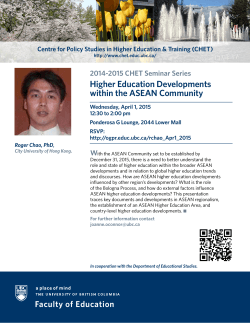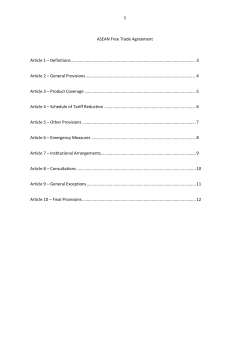
STAKE FOR DEVELOPING COUNTRIES IN THE DOHA ROUND: ASEAN PERSPECTIVE
STAKE FOR DEVELOPING COUNTRIES IN THE DOHA ROUND: ASEAN PERSPECTIVE Anna Maria Rosario D. Robeniol Assistant Director & Head, EERD ASEAN Economic Community Department ASEAN Secretariat ASEAN: SOME BASIC INFORMATION ASEAN is a staunch supporter of the WTO where member states have actively participated in the multilateral process Trade policy in ASEAN member states pursued in three tiers: multilateral (WTO); regional (ASEAN, ASEM, APEC), bilateral More than 75% of ASEAN trade go to nonASEAN countries, e.g. US, Japan, EU, China, etc. ASEAN is building a Community: the ASEAN Economic Community 2015 ASEAN is into regional trading arrangements One member state has yet to be a WTO member ASEAN AND THE DOHA ROUND: WHAT THE ASEAN MINISTERS SAY a “successful Doha Round will spur economic growth and offer a tangible means to reduce poverty globally and in the ASEAN region” the Round “provides a unique opportunity to boost the drive towards development and prosperity in ASEAN” “ASEAN counts on a credible and open multilateral trading system to guide and see the region through this vision [AEC]” “faith on the Doha Development Agenda and its ability to bring about a much stronger and credible WTO, in promoting global economic growth and in providing developing and least developing countries vast opportunities for sustainable growth and development” DOHA ROUND: ISSUES FOR DEVELOPING COUNTRIES launch of a new round of multilateral trade negotiations, with the needs of developing countries at the heart of its agenda, a welcome development Key interests of ASEAN, as developing countries: reforms in agriculture greater market access for industrial goods trade facilitation stronger rules and disciplines, i.e. anti-dumping and subsidies liberalization of trade in services technical cooperation effective dispute settlement mechanism DOHA ROUND: A BALANCED OUTCOME recent pronouncements – renewed hope for the conclusion of the Round living up to the hype – balanced outcome: a comprehensive package in agriculture including substantial reductions in trade-distorting domestic support substantial market access improvements elimination of export subsidies services agreement that would create commercially meaningful and real market access opportunities clearer and improved rules related to administered protection, e.g. anti-dumping, subsidies desired outcome: real, effective and operational development benefits to all developing and leastdeveloped countries ASEAN AND MULTILATERALISM WTO and the conclusion of the Doha Round remains high in ASEAN’s economic agenda for ASEAN economic integration initiatives to succeed, it needs the institutional and legal framework that the WTO provides for the conduct of global trade the Doha Round if prolonged further may cause a serious dent on the relevance and credibility of the multilateral trading system despite ASEAN’s engagement in regional trading arrangements, it still believes in the importance of the WTO in promoting free and fair trade ASEAN AND REGIONALISM FTAs part of ASEAN’s overall economic integration framework and not exactly a response to the lack of progress in the Doha Round FTA negotiations started almost at the same time the Doha Round started ASEAN’s external economic relations, from 2002 to the present, produced 4 FTAs, with: China, Korea, Japan and, Australia and New Zealand; FTA with India in the works consolidation at some point in time – EAFTA or CEPEA expansion of global networks: EU, GCC, Mercosur MULTILATERALISM VS REGIONALISM engagement in FTA negotiations does not diminish the importance ASEAN gives to the WTO primary objectives: secure market access, remain competitive, accelerate integration into the global supply chain, enhance bargaining leverage FTAs designed to be building blocks to the multilateral trading system (WTO Plus): tariff elimination on substantially all trade; comprehensive (trade in services, investment); economic cooperation; special and differential treatment rules and discipline follow that of the WTO FINAL WORD welfare gains from RTAs may or would not be as significant as the gains from liberalizing trade at the multilateral level being dependent on trade for growth and development, developing countries need to continue seeking market opportunities and securing export interests given the uncertainty in the protracted multilateral trade negotiations, regional trading arrangements may yet be the best option for ASEAN member states, in the meanwhile
© Copyright 2025





















